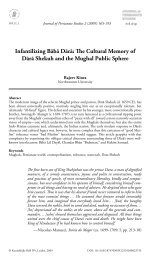The Mughals, the Sufi Shaikhs and the Formation of the Akbari ...
The Mughals, the Sufi Shaikhs and the Formation of the Akbari ...
The Mughals, the Sufi Shaikhs and the Formation of the Akbari ...
Create successful ePaper yourself
Turn your PDF publications into a flip-book with our unique Google optimized e-Paper software.
FORMATION OF THE AKBARI DISPENSATION 167<br />
<strong>of</strong> explicitly combining power (or wilayat) with rulership had, in a<br />
measure, stood in <strong>the</strong> way <strong>of</strong> <strong>the</strong>ir achieving <strong>the</strong> high position <strong>the</strong>y<br />
wanted <strong>and</strong> aspired to. <strong>The</strong>y thus had to reckon with <strong>the</strong> existing<br />
popular <strong>Sufi</strong> orders, assert <strong>and</strong> establish <strong>the</strong> supremacy <strong>of</strong> <strong>the</strong>ir own<br />
order <strong>and</strong> emphasize how it was <strong>the</strong> best, <strong>and</strong> that how even in matters<br />
relating to <strong>the</strong> principle <strong>and</strong> practice <strong>of</strong> poverty <strong>and</strong> asceticism (faqr,<br />
tark-i dunya) <strong>the</strong>y were really far ahead <strong>of</strong> <strong>the</strong> Chishtis. <strong>The</strong>y always<br />
remained within <strong>the</strong> limits <strong>of</strong> <strong>the</strong> traditions <strong>of</strong> <strong>the</strong> Prophet, <strong>and</strong> stated<br />
that <strong>the</strong>ir primary task was to achieve ‘<strong>the</strong> purpose <strong>of</strong> <strong>the</strong> Muslims’,<br />
even as <strong>the</strong>y engaged with worldly politics <strong>and</strong> trafficked with kings.<br />
Two fur<strong>the</strong>r major Naqshb<strong>and</strong>i saints, Khwaja Khaw<strong>and</strong> Mahmud<br />
‘Alavi Husaini (d. 1652) <strong>and</strong> Khwaja Baqi-Billah (d. 1603), came to<br />
India <strong>and</strong> established <strong>the</strong>ir khanqahs during Akbar’s reign. Khaw<strong>and</strong><br />
Mahmud was perhaps <strong>the</strong> first to be directed by his pir, Shaikh<br />
Muhammad Ishaq Dehbidi (d. 1599) to come to India to propagate<br />
<strong>the</strong> Naqshb<strong>and</strong>i mission. <strong>The</strong>reupon he joined a caravan <strong>and</strong> set out<br />
for Lahore. When he arrived in <strong>the</strong> town <strong>of</strong> Gujarat in <strong>the</strong> Punjab<br />
where <strong>the</strong> road bifurcated, one path leading to Kashmir, <strong>the</strong> o<strong>the</strong>r to<br />
Lahore, he fell into a mystic trance <strong>and</strong> his horse took <strong>the</strong> route <strong>of</strong><br />
Kashmir. After he regained consciousness, he decided to continue his<br />
journey in <strong>the</strong> direction <strong>of</strong> Kashmir, thinking that this was what God<br />
<strong>and</strong> his master would have wanted. He settled in Kashmir, <strong>and</strong> though<br />
initially he had some difficulty, succeeded in establishing <strong>the</strong> order on<br />
a firm footing in <strong>the</strong> Valley. His son <strong>and</strong> successor, Khwaja Mu’in<br />
al-Din (d. 1674) also was a prominent saint in <strong>the</strong> Valley. Khaw<strong>and</strong><br />
Mahmud’s influence, despite his efforts to come close to some nobles<br />
in Delhi <strong>and</strong> Agra, did not really extend beyond <strong>the</strong> Valley. 92<br />
It was hence Khwaja Muhammad Baqi-Billah—a member <strong>of</strong> <strong>the</strong><br />
family <strong>of</strong> Khwaja Ahrar from his mo<strong>the</strong>r’s side—who took up <strong>the</strong><br />
challenge <strong>of</strong> reinstating <strong>the</strong> Naqshb<strong>and</strong>i order in <strong>the</strong> heartl<strong>and</strong> <strong>of</strong><br />
Mughal Hindustan. He came to settle in Delhi from Kabul in 1599,<br />
inspired <strong>and</strong> perfected in <strong>the</strong> order by Khwaja Muhammad Muqtada<br />
Amkinagi (d. 1600). He had earlier been to India, lived <strong>and</strong> w<strong>and</strong>ered<br />
in Sambhal, Lahore <strong>and</strong> Kashmir. He lived very briefly in Delhi, for<br />
slightly over 4 years, but before his premature death in 1603 he had<br />
92 S.A.A. Rizvi, A History <strong>of</strong> <strong>Sufi</strong>sm, Vol. II, pp. 181–5. For a comprehensive<br />
discussion <strong>of</strong> Khaw<strong>and</strong> Mahmud’s career, see David W. Damrel, ‘Forgotten grace:<br />
Khwaja Khaw<strong>and</strong> Mahmud Naqshb<strong>and</strong>i in Central Asia <strong>and</strong> Mughal India’, Ph.D.<br />
Dissertation, Department <strong>of</strong> Religion, Duke University, 1991. See also Shamsuddin<br />
Ahmad, Hazrat Khwaja Naqshb<strong>and</strong> aur Tariqat-i Naqshb<strong>and</strong>iya (in Urdu) (Srinagar:<br />
Gulshan Publishers, 2001), pp. 358–407.<br />
http://journals.cambridge.org Downloaded: 15 Feb 2011 IP address: 129.174.97.34






